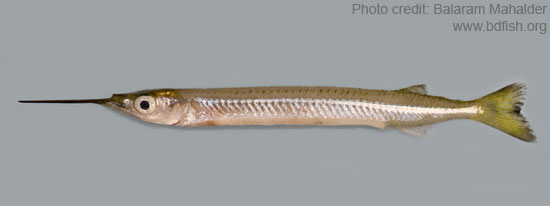
Systematic position
Phylum: Chordata
Class: Actinopterygii (Ray-finned fishes)
Order: Beloniformes (Needlefishes)
Suborder: Belonoidei (= Exocoetoidei)
Superfamily: Exocoetoidea
Family: Hemiramphidae (Halfbeaks)
Subfamily: Hemiramphinae
Genus: Hyporhamphus
Species: H. limbatus
Synonyms
Hemiramphus gorakhpurensis Srivastava, 1967
Hemiramphus limbatus Valenciennes, 1847
Hemiramphus tridentifer Cantor, 1849
Hemirhamphus sinensis Günther, 1866
Hyporhamphus sinensis (Günther, 1866)
Common/local names
English: Congaturi halfbeak
Bangladesh: Ek Thuita (এক ঠুইটা), Ek Thuitta (ঠুইট্টা বা থুইট্টা) and Ek Thota (এক ঠোটা)
Distributions: Bangladesh (Rahman, 1989 and 2005); Persian Gulf, India, Pakistan, Sri Lanka, Myanmar, to Thailand and China (Talwar and Jhingran, 1991).
Conservation status: Not threatened in Bangladesh (IUCN Bangladesh, 2000).

Morphology: Body elongate, cylindrical to compressed with lower beak greatly produced. Upper jaw short, triangular, slightly broader than long with a mesial keel. Teeth villiform in many rows on both jaws. This fish is oviparous.
Head including beak 2.5-2.8 in standard, 2.9-3.2 in total length. Height 10.0-11.0 in standard, 11.0-12.0 in total length. Eye 8.0-10.0, snout 1.3-1.6, interorbital 1.0. Length of beak 4.5-5.0 in standard, 5.2-5.9 in total length, lower jaw 5.6 times as long as upper jaw (Rahman, 1989 and 2005).
Dorsal originates opposite anal, Its base approximately equal to that of anal. Pelvics originate about midway between posterior edge of eye and caudal base. Caudal deeply forked, lower lobe longer. Dorsal and anal rays in males not modified. Dorsal and anal fins inserted in posterior of body.
Lateral line running lower part of body and with 50-52 (Rahman, 1989 and 2005) scales. dorsal and anal fins with no scales. Silvery or yellowish-white with a silvery lateral band which is broader posteriorly. Scales on upper half with minutesblack dots. Caudal, dorsal and anal fins with dark edges (Rahman, 1989 and 2005).
Fin formula:
D. 13-14; P. 10; V. 6; A. 13-15; C. 14 (Bhuiyan, 1964; Shafi and Quddus, 2001)
D. 13-14; P1. 10; P2. 6; A. 13-14 (Rahman, 1989 and 2005)
D 12-16; A 13-16; P i 10-11; V i 5 (Talwar and Jhingran, 1991)
Maximum lengths: 19 cm (Bhuiyan, 1964), 15.3 cm (Rahman, 1989 and 2005), 18.5 cm (Shafi and Quddus, 2001) and 22 cm (Huda et al., 2003).
Habitats: Inhibits coastal waters, estuaries and freshwaters (Talwar and Jhingran, 1991). In large rivers (Shafi and Quddus, 2001). This fish is mainly riverine and found mostly in Southern-Eastern districts of Bangladesh (Rahman, 1989; IUCN Bangladesh, 2000). Common in the Chilka lake of Orissa (Talwar and Jhingran, 1991). Available in the Sundarbans (Huda et al., 2003).
Breeding: Breed at least twice in a year (Talwar and Jhingran, 1991). Eggs are round measuring 1.3 mm in diameter and are provided with 1-3 anchoring threads with which they attach to aquatic vegetations; hatching generally takes place on the eighth day (Bhuiyan, 1964).
Fishery info: Of no interest to fisheries (Talwar and Jhingran, 1991).
__________________________________________________________
REFERENCES
Bhuiyan AL (1964) Fishes of Dacca, Asiat. Soc. Pakistan, Pub. 1, No. 13, Dacca, pp. 87-88.
Cantor TE (1849) Catalogue of Malayan fishes. Journal and Proceedings of the Asiatic Society of Bengal 18(2): i-xii + 983-1443, Pls. 1-14.
Cuvier G and Valenciennes A (1847) Histoire naturelle des poissons. Tome dix-neuvième. Suite du livre dix-neuvième. Brochets ou Lucioïdes. Livre vingtième. De quelques familles de Malacoptérygiens, intermédiaires entre les Brochets et les Clupes. Histoire naturelle des poissons. 19: i-xix + 1-544 + 6 pp., Pls. 554-590.
Günther A (1866) Catalogue of fishes in the British Museum. Catalogue of the Physostomi, containing the families Salmonidae, Percopsidae, Galaxidae, Mormyridae, Gymnarchidae, Esocidae, Umbridae, Scombresocidae, Cyprinodontidae, in the collection of the British Museum. Catalogue of the fishes in the British Museum. 6: i-xv + 1-368.
Huda MS, Haque ME, Babul AS and Shil NC (ed.) (2003) Field guide to finfishes of Sundarban, Aquatic resources division, Sundarban, Boyra, Khulna, Bangladesh, p. 96.
IUCN Bangladesh (2000) Red book of threatened fishes of Bangladesh, IUCN- The world conservation union. xii+116 pp.
Rahman AKA (1989) Freshwater Fishes of Bangladesh, 1st edition, Zoological Society of Bangladesh, Department of Zoology, University of Dhaka, Dhaka-1000, pp. 58-59.
Rahman AKA (2005) Freshwater Fishes of Bangladesh, 2nd edition, Zoological Society of Bangladesh, Department of Zoology, University of Dhaka, Dhaka-1000, pp. 73-74.
Shafi M and Quddus MMA (2001) Bangladesher Matsho Shampad (Fisheries of Bangladesh) (in Bengali), Kabir publication. Dhaka, Bangladesh. pp. 242-243.
Srivastava GJ (1967) A new species of freshwater fish of the genus Hemiramphus Cuv. from Gorakhpur, Uttar Pradesh, India. Journal of the Bombay Natural History Society 64 (1): 93-94.
Talwar PK and Jhingran AG (1991) Inland Fishes of India and Adjacent Countries, Vol. 2, Oxford & IBH Publishing Co. Pvt. Ltd. New Delhi-Calcutta, p. 734.
Visited 2,190 times, 1 visits today | Have any fisheries relevant question?
